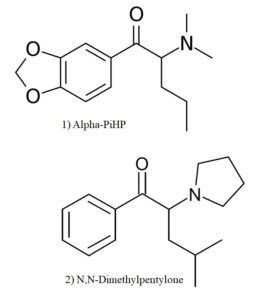By Kevin Shanks, M.S., D-ABFT-FT
As mentioned in the previous post, novel psychoactive substances (NPS) come in different flavors – and opioids, cannabinoids, stimulants, hallucinogens, and benzodiazepines are just a few of them. The Novel Emerging Compounds (NEC) Panel offered by Axis Forensic Toxicology helps to detect the most newly emerged NPS on the drug market and is meant to continually evolve over time as new substances emerge on the street.
In the first post in this series, we took a look at two of the more recently emerged NPS benzodiazepines, and in this second post, we are looking at two of the most recently detected stimulants: alpha-PiHP and N,N-dimethylpentylone.
Alpha-PiHP, also known as 4-methyl-1-phenyl-2-(pyrrolidin-1-yl)pentan-1-one or alpha-pyrrolidinoisohexanophenone, is a substituted cathinone that is a positional isomer of the prescription medication pyrovalerone, a norepinephrine-dopamine reuptake inhibiting drug that is used for the treatment of chronic fatigue and as an appetite suppressant. Alpha-PiHP was first reported as being a drug sold on the illicit drug market in 2016 by the National Forensic Laboratory of Slovenia when it was detected in an off-white colored powder. In the United States in 2018, the Center for Forensic Science Research and Education (CFSRE) first reported the detection of the substance in a white solid material via the Department of Homeland Security.

Chemical Structures of Alpha-PiHP, Dimethylpentylone Structures drawn by Kevin G. Shanks (2023).
N,N-dimethylpentylone is also known as 1-(1,3-benzodioxol-5-yl)-2-(dimethylamino)pentan-1-one or dipentylone and is a substituted cathinone that is a positional isomer of a previously reported cathinone, N-ethylpentylone, a norepinephrine-dopamine-serotonin reuptake inhibitor. Pentylone is a common metabolite produced by the body via de-ethylation after consumption of N,N-dimethylpentylone. The drug was first identified in Sweden in 2014, but didn’t emerge in the United States until 2021-2022.
Similar to other classical stimulants such as methamphetamine and amphetamine, these two compounds act pharmacologically as central nervous system stimulants with activity involving the neurotransmitters serotonin, norepinephrine, and dopamine. While the human pharmacology of these substances hasn’t been readily tested, it is surmised that they act as either direct releasers of the neurotransmitters or as transporter inhibitors. Reported effects after use of substances such as these include increased alertness, increased energy, euphoria, feelings of well-being, restlessness, and hallucination. Other physiological effects are hyperthermia, tachycardia, hypertension, mydriasis, diaphoresis, dehydration, and hyponatremia.
While not explicitly listed as controlled substances in the United States, both of the substances may be considered positional isomers of already controlled drugs and therefore be considered “analogues”. According to the Drug Enforcement Administration’s (DEA) National Forensic Laboratory Laboratory Information System (NFLIS) 2022 Midyear Drug Report, N,N-dimethylpentylone was the third most common phenethylamine detected by the DEA – behind only methamphetamine and amphetamine. Alpha-PiHP was the sixth most commonly detected phenethylamine in 2022. Alpha-PiHP and N,N-dimethylpentylone have been implicated in human toxicity which have led to numerous hospitalizations and fatalities in the USA.
Axis qualitatively monitors both of these compounds in our NEC panel (order code 13710) and Comprehensive Panel, Blood with Analyte Assurance (order code 70510) using liquid chromatography with quadrupole time of flight mass spectrometry (LC-QToF-MS). Over the time range 01/30/2023 – 06/30/2023, Axis has detected alpha-PiHP in 11 blood specimens with all detections located in Florida and N,N-dimethylpentylone in 42 cases with 41 cases in Florida and 1 case in Indiana. The reason why these compounds have been predominately found in Florida is not known, but NPS and classical drug trends tend to be regional phenomena.
In Axis Forensic Toxicology casework, Alpha-PiHP was typically found alongside fentanyl/norfentanyl (n=6), 4-ANPP (n=5), N,N-dimethylpentylone (n=5), cocaine/benzoylecgonine (n=3), and naloxone (n=3). N,N-dimethylpentylone was simultaneously detected with fentanyl/norfentanyl (n=30), 4-ANPP (n=29), pentylone (n=21), cocaine/benzoylecgonine (n=18), and naloxone (n=14).
Axis also monitors other NPS stimulants in our Novel Psychoactive Substances panel (order code 13610). These additional compounds include alpha-PVP, butylone, dibutylone, dimethylone, eutylone, MDPV, mephedrone, methcathinone, methedrone, methylone, N-ethylpentylone, pentylone, and TFMPP. As always, if you have questions about these substances and how they may play a role in your medical-legal investigation, please reach out to our subject matter experts by email ([email protected]) or phone (317-759-4869, Option 3).
Stay tuned for the third post in the NEC Panel series! We will take a look at two more recently emerged novel compounds: phenibut and tianeptine.
